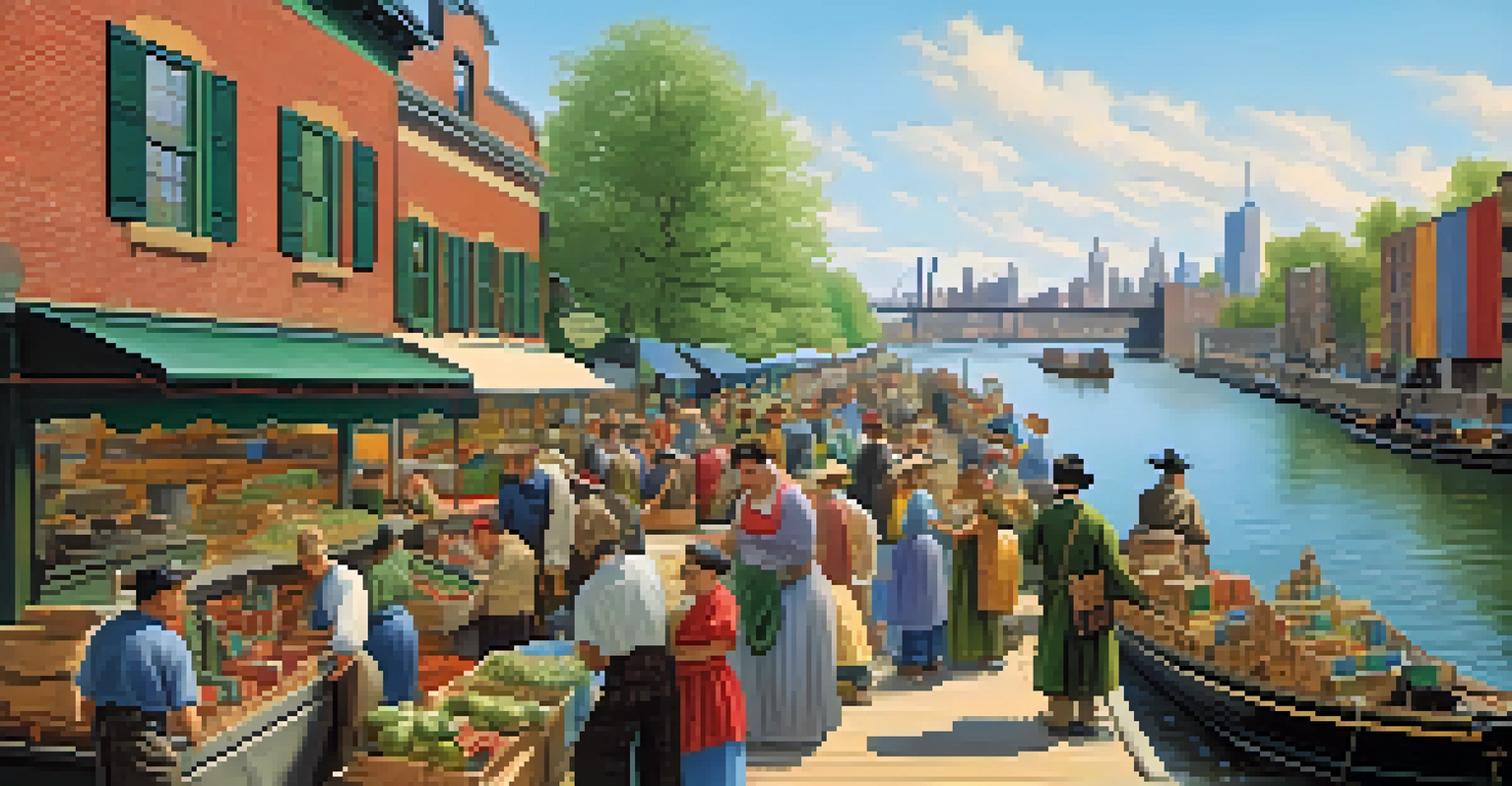The Construction of the Erie Canal: Transforming NYC in 1825

The Vision Behind the Erie Canal Construction
The Erie Canal was born from an ambitious vision to link the Hudson River to Lake Erie. This connection aimed to create a direct waterway for transporting goods, making trade more efficient. With the growing population and economic demands of New York, leaders recognized that enhancing transportation was crucial for the city’s future.
The canal was a great work of human ingenuity, bringing together men from different backgrounds to achieve a common goal.
Governor Dewitt Clinton was a key figure in championing this project, despite facing skepticism from many. He believed that a canal would not only spur economic growth but also position New York City as a major trade hub. His relentless advocacy set the stage for what would become a monumental engineering feat.
The project started in 1817, fueled by the promise of economic prosperity. Workers from various backgrounds came together, driven by the hope that the canal would transform their lives and the economy of New York state.
Engineering Marvel: The Challenges Faced
Constructing the Erie Canal was no small task; it presented numerous engineering challenges. Workers had to navigate through rugged terrain, swamps, and rivers, requiring innovative solutions. The use of locks, which raised and lowered boats, was a groundbreaking concept that allowed for the canal's elevation changes.

Labor was a significant aspect of the construction, with thousands of men, including Irish immigrants, working under tough conditions. The labor force faced difficult and sometimes dangerous tasks, battling the elements and the landscape itself. This collective effort was a testament to human determination and ingenuity.
The Erie Canal Transformed Trade
The completion of the Erie Canal revolutionized trade by drastically reducing shipping costs and connecting the Midwest with New York City.
Despite the hardships, the canal's construction progressed steadily, embodying a spirit of perseverance. By 1825, the hard work paid off, and the canal was officially completed, marking a monumental achievement in American engineering.
Economic Impact: The Canal's Role in Trade
Once completed, the Erie Canal revolutionized trade in New York City and beyond. It drastically reduced shipping costs, allowing goods to move more efficiently between the Midwest and the East Coast. This economic transformation helped New York City emerge as a dominant trading port in the United States.
The Erie Canal opened the West to the East, transforming trade and the economy in ways we could have only dreamed.
Farmers in the Midwest found new markets for their produce, while New York merchants benefited from a wider variety of goods. The canal facilitated a more robust economy, encouraging investment and the growth of industries. This interconnectedness laid the groundwork for the modern economy we see today.
The influx of goods and people through the canal also led to a population boom in New York City. As the city thrived, it attracted more immigrants, contributing to its vibrant and diverse culture that continues to shape it today.
Cultural Shifts: The Canal's Influence on Society
The Erie Canal not only transformed the economy but also influenced the cultural landscape of New York City. As trade flourished, so did the exchange of ideas and cultures, fostering innovation in arts and literature. The increased connectivity allowed for a rich tapestry of influences that shaped the city’s identity.
Local communities along the canal flourished, creating a network of towns and cities that contributed to New York's growth. This connectivity made it easier for people to travel, share stories, and celebrate their heritage, leading to a more diverse society. The canal became a lifeline, connecting diverse populations and fostering a sense of community.
Cultural Exchange Flourished
As trade increased, the Erie Canal facilitated a rich cultural exchange, fostering innovation in arts and creating a diverse community.
Cultural events and gatherings emerged, reflecting the blend of various traditions, further enriching New York City's character. The Erie Canal was more than a transportation route; it became a symbol of progress, unity, and innovation.
Environmental Considerations: Balancing Nature and Progress
While the Erie Canal brought significant benefits, it also raised environmental concerns. The construction altered natural landscapes, affecting ecosystems and waterways. This change prompted early discussions about the balance between development and environmental preservation.
As the canal became integral to New York's economy, debates emerged about its long-term impact on local wildlife and habitats. The introduction of new species and changes in water flow posed challenges that required attention. The situation sparked an awareness of the need for sustainable practices, even in the early 19th century.
The lessons learned from the canal's construction influenced future infrastructure projects, emphasizing the importance of considering environmental impacts. This awareness paved the way for more responsible planning and development practices in years to come.
Legacy of the Erie Canal: A Lasting Impact
The legacy of the Erie Canal extends far beyond its initial construction. It laid the foundation for a transportation network that would evolve over the decades. The canal system inspired similar projects across the country, promoting economic development and connectivity.
Today, the Erie Canal is celebrated not only as a vital economic artery but also as a historical landmark. It serves as a reminder of the innovative spirit that shaped New York and the United States as a whole. The canal's story continues to be told, inspiring future generations.
Environmental Impact Awareness
The construction of the Erie Canal raised early discussions about the balance between development and environmental preservation.
In modern times, the canal has also become a recreational hub, attracting tourists and outdoor enthusiasts. The transformation from a commercial waterway to a leisure destination reflects the dynamic nature of this historical achievement, ensuring that its impact is felt for years to come.
Conclusion: The Erie Canal's Role in NYC's Transformation
In summary, the construction of the Erie Canal in 1825 was a pivotal moment in New York City's history. It not only transformed the city economically but also socially and culturally. The canal connected diverse communities, fostered innovation, and established New York as a major trade hub.
The challenges faced during construction and the environmental considerations addressed along the way highlight the complexity of such a monumental project. As we reflect on the Erie Canal's legacy, we see the importance of balancing progress with sustainability.

Ultimately, the Erie Canal remains a symbol of human ingenuity and collaboration, shaping the course of New York City and leaving an indelible mark on the nation's history.